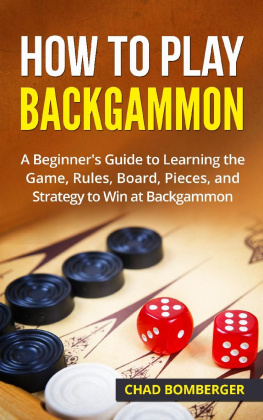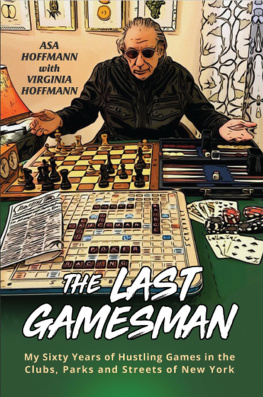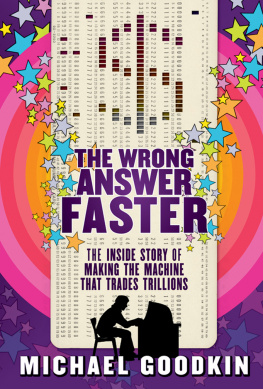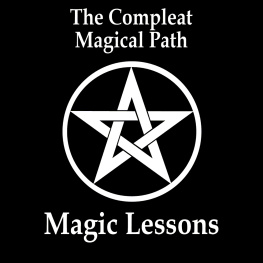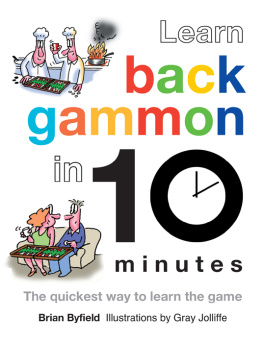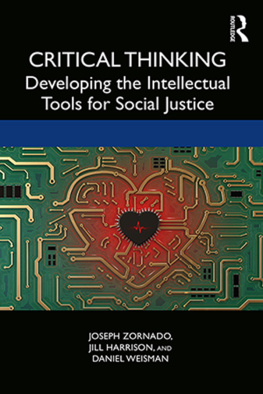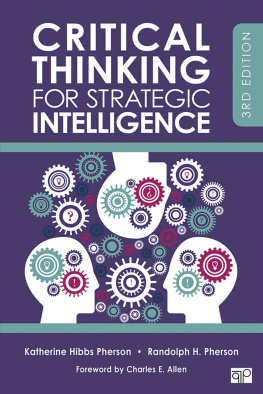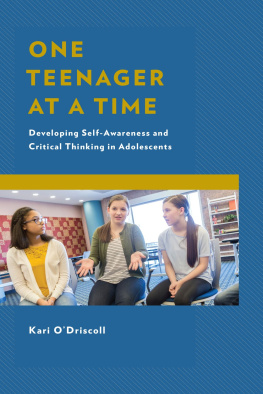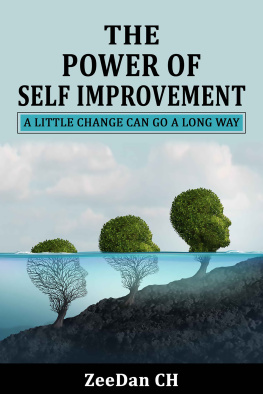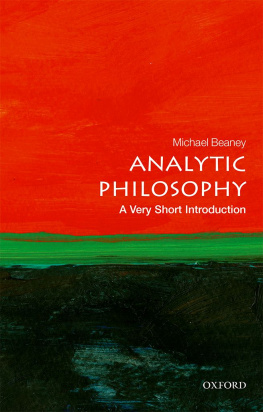Dobias - The Magic of Backgammon: 20 Lessons for the Developing Player
Here you can read online Dobias - The Magic of Backgammon: 20 Lessons for the Developing Player full text of the book (entire story) in english for free. Download pdf and epub, get meaning, cover and reviews about this ebook. year: 2014, publisher: Double Sixes, genre: Children. Description of the work, (preface) as well as reviews are available. Best literature library LitArk.com created for fans of good reading and offers a wide selection of genres:
Romance novel
Science fiction
Adventure
Detective
Science
History
Home and family
Prose
Art
Politics
Computer
Non-fiction
Religion
Business
Children
Humor
Choose a favorite category and find really read worthwhile books. Enjoy immersion in the world of imagination, feel the emotions of the characters or learn something new for yourself, make an fascinating discovery.
The Magic of Backgammon: 20 Lessons for the Developing Player: summary, description and annotation
We offer to read an annotation, description, summary or preface (depends on what the author of the book "The Magic of Backgammon: 20 Lessons for the Developing Player" wrote himself). If you haven't found the necessary information about the book — write in the comments, we will try to find it.
Dobias: author's other books
Who wrote The Magic of Backgammon: 20 Lessons for the Developing Player? Find out the surname, the name of the author of the book and a list of all author's works by series.
The Magic of Backgammon: 20 Lessons for the Developing Player — read online for free the complete book (whole text) full work
Below is the text of the book, divided by pages. System saving the place of the last page read, allows you to conveniently read the book "The Magic of Backgammon: 20 Lessons for the Developing Player" online for free, without having to search again every time where you left off. Put a bookmark, and you can go to the page where you finished reading at any time.
Font size:
Interval:
Bookmark:
Radek Dobias
Copyright 2013 Radek Dobias
All Rights Reserved. No part of this publication may be reproduced, stored in a retrieval system, or transmitted, in any form or in any means by electronic, mechanical, photocopying, recording or otherwise without prior written permission.
Where am I, or what? From what causes do I derive my existence, and to what condition shall I return? ... I am confounded with all these questions, and begin to fancy myself in the most deplorable condition imaginable, enclosed with the deepest darkness, and utterly deprived of the use of every member and faculty. Most fortunately it happens, that since Reason is incapable of dispelling these clouds, Nature herself suffices to that purpose, and cures me of this philosophical melancholy and delirium, either by relaxing this bent of mind, or by some avocation, and lively impression of my senses, which obliterate all these chimeras. I dine, I play a game ofbackgammon, I converse, and am merry with my friends. And when, after three or four hours' amusement, I would return to these speculations, they appear so cold, and strained, and ridiculous, that I cannot find in my heart to enter into them any farther.
-David Hume
Table of Contents
To my parents. You did quite a number on me. I will never forget that.
To Ami. Your smile always makes my day.
To screenwriters of Lost, who got me into backgammon in the first place.
Backgammon affords deep intellectual gratification, attainable through careful analytic thinking and a personal commitment to constant improvement. In those regards, mistakes are the most fruitful field to explore. The subtler facets of the game that we either do not understand or only partially grasp are what keeps backgammon from ever becoming boring or trite.
Chances are you feel the same. I suspect you have a strong passion for the game, otherwise you would not be reading this book. You may be a beginner, an intermediate player, or an expert. It doesn't matter, as all players can get something out of it.
If you are a beginner, you may be wondering if this book is too difficult for you. Let me assure you that it isn't. You may find many positions and concepts challenging, as they will go against what you know or think you know about backgammon. But don't worry. There is enough in the book to teach you what is correct and what it isn't... and why that is the case.
If you are an intermediate player (which I define as someone between a beginner and an expert), you will get the most out of this book. That's because the concepts and examples contained herein challenge the thinking of typical intermediate players and point out the mistakes they often make.
If you are an expert, it is my hope that the book may afford you the pleasure of studying interesting positions, as well as testing yourself to see if your backgammon skills indeed match with reality.
It is my hope that readers spend many enjoyable moments with the book, and that the ideas and the analysis are helpful and revealing.
After playing chess, go, hex, othello, mahjong, and poker for many years, I discovered backgammon. I instantly fell in love with it, and started playing seriously. I climbed from an absolute beginner to an expert (1900+ rating) in a matter of only 3 months by playing against strong AI (Artificial Intelligence software) for several hours every day.
I am not alone in achieving such a feat. Nack Ballard is famous for becoming one of the best in the world in the same way (not that I would claim to be one of the best :)). In fact, such training has become the new orthodoxy among backgammon players worldwide. AI is better than humans, and has been for a long time. It is the ultimate opponent and tutor.
However, merely playing against the computer is not sufficient. There is a need to be able to understand the software's evaluations using dynamic principles. There are good, rational reasons why certain moves are better than others. In each lesson, we will explore these.
By rules, I mean the rules of thumb such as 'always make the 5 point' or 'when you can, hit', not the rules of the game.
Rules of thumb are great for beginners, because they give easy-to-follow guidelines. These are especially valuable in unclear, tricky situations that no beginner could possibly evaluate with accuracy.
However, rules become less important and even detrimental to intermediate players. There is a danger of playing on auto-pilot. Instead of taking time to analyze a position, the player simply applies a rule without thinking about the context of his play.
For experts, the rules are unnecessary. Experts know the rules, but are keenly aware of strategic context which determines if any particular rule applies in a given situation. They don't make 5 points automatically nor do they hit blindly.
Experts often reason from first principles, especially when faced with unclear or unfamiliar positions.
Examples of principles would be: 'greater mobility is preferable to lesser mobility', or 'you can play more boldly if you have an advanced anchor'. For a list of good principles, see Appendix B.
Rules are great, but playing from principles means knowing when to break the rules. That's what this book is about.
The lessons and the problems in this book are about checker play; there are no cube situations included. This is because the developing player should first focus on checker play and only after mastering it, should concern himself with the cube.
The cube decisions are the hardest part of the backgammon.
Walk before you can fly.
Learn to walk well.
All positions come from real games and were analyzed with GNU Backgammon, cubeful, 1-point matches, on the Grandmaster setting (3-ply).
You are always black to play. Your nemesis is always white and referred to as a 'she'. This is not a dig at women, but simply a convention to make the text more readable.
Each discussion includes a percentage position evaluation, expressed as MWC (Match Winning Chances). Thus, the best move will always have a higher MWC than the alternatives.
The alternatives are includes for at least 2 reasons:
It is crucial to recognize alternative moves.
It is educational to analyze and discuss 2nd and 3rd best moves, and to know why they fall short.
But enough talking.
It's Black to move.

Let's start simple.
The game is one move old. The opponent rolled 6/1 and predictably made the bar point.
How do you make the most of your 3s?
Discussion
The opponent started building her prime, so it's a good idea to play 24/12(2) to create an advanced anchor. But what about the other 3s?
You can make the 5 point with 8/5(2), but should you?
We are conditioned by classic backgammon teachers to think of making the 5 point as a 'must' play. Phil Simborg is fond of telling stories of his lessons with Nack Ballard. With respect to what he learned from Nack, he says:
The best lesson I learned from Nack is: Make the five-point. Almost any time you can, almost regardless of the other choices, making the five-point is right. Back when he was teaching me this, the computer programs did not agree. Now, they have gotten better and they agree with Nack. (
Font size:
Interval:
Bookmark:
Similar books «The Magic of Backgammon: 20 Lessons for the Developing Player»
Look at similar books to The Magic of Backgammon: 20 Lessons for the Developing Player. We have selected literature similar in name and meaning in the hope of providing readers with more options to find new, interesting, not yet read works.
Discussion, reviews of the book The Magic of Backgammon: 20 Lessons for the Developing Player and just readers' own opinions. Leave your comments, write what you think about the work, its meaning or the main characters. Specify what exactly you liked and what you didn't like, and why you think so.


